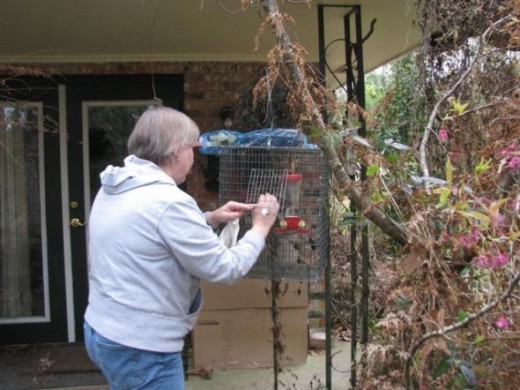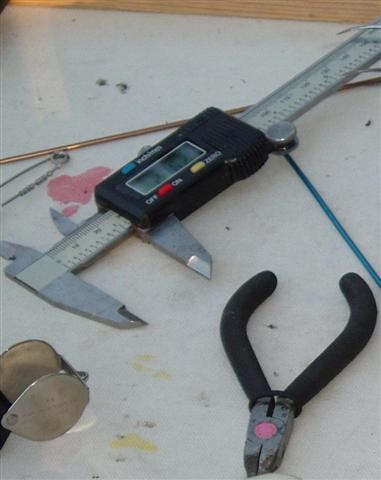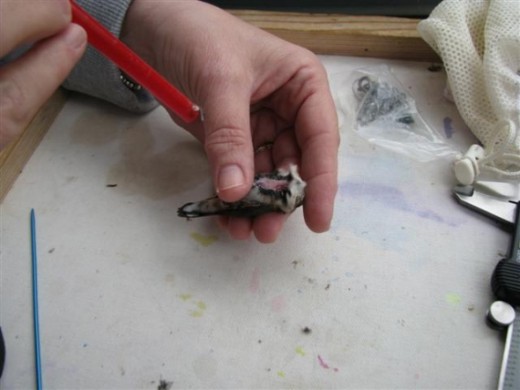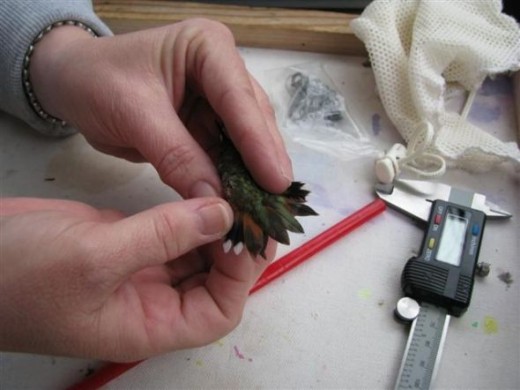Banding a Hummingbird

Why and How is This Banding Done?
Each year thousands of hummingbirds move through Louisiana during fall and spring migration. Some of the species of this bird which breed in western North America choose not to go across the Gulf of Mexico to the normal wintering grounds in Mexico and Central America and instead, stay in the semi tropical and tropical states along the Gulf Coast. This is the story of one of those birds, an immature female Rufous (Selasphorus rufus) who arrived in my yard in Covington, LA before Thanksgiving and was captured, banded and released on February 21, 2010.
Photos are by Y.L. Bordelon aka naturegirl, All Rights Reserved.
Rufous Spends the Winter

My husband first saw our little winter visitor right before he went into the hospital. He just got a quick look and then she was gone. Several days later, the day after Thanksgiving, I got a pretty good look as she drank from the feeder by our porch and tentatively identified it as a female or immature Selasphorus, probably a Rufous. We leave our feeders up, filled with fresh sugar water solution year round because it is not uncommon to have a winter hummingbird in our area.
In a few days, I was able to get some photographs of the new arrival and I emailed a few shots to Linda Beall, our Covington Hummingbird researcher. She also thought that it was a Rufous (Selasphorus rufus), but her knowledge and experience enabled her to narrow the identification down to an immature female.
Hummingbird banders are an elite group that are permitted by the USGS Bird Banding Lab, to humanely capture and band these tiny birds. Many of these individuals are self-taught volunteers who have apprenticed with an experienced, permitted bander. They pay for their own equipment and transportation to banding sites and gather much valuable data about the movement and habits of these little birds.
Banding Poll
Have you ever been to a hummingbird banding session?
Rufous Female Brightens the Drab Winter

Rufous Female Hummingbird poster by naturegirl7
Throughout the next few months, I continued to see the little Rufous and was able to take more pictures. In the photographs, you can see the moulting process where the young bird looses the more dull immature feathers and replaces them with brighter, adult plumage. Especially noticeable was the growth of the circular gorget right in the middle of the throat that most adult female Rufous have. The number of red feathers varies among individuals, so it is a pretty good way to identify them.
Fall turned to winter and neither Linda nor I were able to set up a time to capture the wintering hummingbird. Finally, with our winter season almost over, we were able to get together on February 21, 2010 to capture and band the Rufous. By now, she was considered a second year bird and had moulted into much of her adult plumage.
Hummer Banding Quiz
view quiz statisticsRufous Female in Bush Poster

Rufous Female in Bush by naturegirl7
Hummingbird Banding Session
I have always felt that a picture is worth a thousand words, so I documented the research capture session, step by step so that it is almost like being there. Hope you enjoy the process.
Humanely Trapping the Bird

The researchers with USGA permits here in Louisiana use specially designed traps with remote control devices to capture hummingbirds.
Securing the Tiny Thing

Even in a cage, a hummingbird is difficult to catch, but the expert soon has the feisty little bird under control.
Placing in a Bag

The little female is placed in a mesh bag for safe keeping, while Beall sets up her equipment.
Checking for a Band

Since the identification bands are so tiny, they may be overlooked. The researcher always checks to see if someone has already banded a bird. If one is found, the number is recorded and the USGA Banding Lab is contacted to see who captured the bird and where. This hummer had not been previously banded.
Putting on the Band

The id bracelet is placed on the left leg and is checked to make sure that the fit is right. The number is recorded on the data sheet.
Hummingbird Bands

Each has a unique number code which is registered to an individual researcher. All the data taken about each bird is sent to the banding lab so the movements of this bird can be tracked.
Researcher's Tools

When a researcher receives his/her bands they come in sheets and must be cut out and made into the tiny ringlets. There are about 25 hummer bands on the diaper pin on the top left of the photo.
Counting Gorget Feathers

Most female Rufous have a circular pattern of red feathers in the middle of their throats. The number of feathers varies from bird to bird, so Linda counts the number of feathers present at the time of banding. This aids in future identification of this individual.
Checking for Fat

Before migrating, hummingbirds build up a layer of fat. Here she uses the straw to blow the feathers aside to see how much fat is on each bird that she captures. This Rufous female has very little fat, so she will probably stay at our place for a while longer.
Checking Tail Feathers

The tail feathers of our Rufous have already grown into the adult plumage. Immature feathers have white tips. Notice the feathers with the nipple like tip (near the middle of the tail) that are rust and green. These are one of the key identifiers of a Rufous hummingbird and distinguishes them from other Selasphorus like Allens or Broad-tailed.
Checking Wings

The condition of the wings is checked. The first primary of this female has grown back about 50%. Because of this, an accurate wing measurement could not be taken.
Checking for Corrugation "Bumps"

Very young birds have many "washboard" type bumps on the top of their bills called corrugation. Most of these bumps are worn away during the first year. This one has 50% corrugation.
Measuring the Bill

Measurements are another way to determine the species of a hummingbird. Rufous fall into an established range. Linda uses calipers to get a precise measurement of the bill.
Measuring the Tail

The tail is also measured to see if it falls within the given range for Rufous hummingbirds.
Weighing the Bird

Weighing is another way to establish how much fat has been stored as well as the general condition of the individual. The scale was set at zero with the stocking bag on it. The measurement is in grams.
Adult Female Rufous Tail Feathers

Female and immature male Rufous hummingbirds have white tips on the 3 outside tail feathers. The rust coloring at the base of the tail feathers is another Rufous trait.
Posing Before Release

Hummingbird feathers are irridescent and look dark, except when the sunlight hits them just right. This female has a nice red gorget spot.
Visible ID Mark

Before a tiny flyer is released, Linda places a spot of water soluble correction fluid on the top of its head. The water-based formula is much like tempera paint. This makes a visual identification easier if there are more than one bird at a location. Sometimes, you think you are seeing the same one and after putting on the paint ID spot, you realize that there are actually two birds.
Release

Beall placed the female Rufous in my hand for our last photo op. She sat there for a couple of minutes until Linda blew on her tail. Then she was off and back to her favorite brushy spot on the west side of the yard.
Hummingbird Haven
© 2010 Yvonne L B








